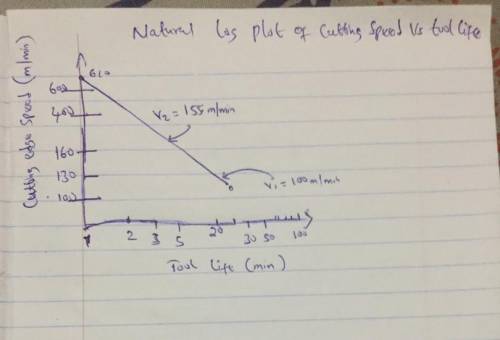
Engineering, 14.07.2020 01:01 brydenskl814
Flank wear data were collected in a series of turning tests using a coated carbide tool on hardened alloy steel at a feed of 0.30 mm/rev and a depth of 4.0 mm. At a speed of 100 m/min, flank wear = 0.12 mm at 1 min, 0.27 mm at 5 min, 0.45 mm at 11 min, 0.58 mm at 15 min, 0.73 at 20 min, and 0.97 mm at 25 min. At a speed of 155 m/min, flank wear = 0.22 mm at 1 min, 0.47 mm at 5 min, 0.70 mm at 9 min, 0.80 mm at 11 min, and 0.99 mm at 13 min. The last value in each case is when final tool failure occurred.(a) On a single piece of linear graph paper, plot flank wear as a function of time for both speeds. You may use Excel to help yourself to plot the curve. Using 0.75 mm of flank wear as the criterion of tool failure, determine the tool lives for the two cutting speeds.(b) Calculate the values of n and C in the Taylor equation solving simultaneous equations.

Answers: 1


Another question on Engineering

Engineering, 04.07.2019 18:10
Slip occurs via two partial dislocations because of (a) the shorter path of the partial dislocation lines; (b) the lower energy state through partial dislocations; (c) the charge balance.
Answers: 1

Engineering, 04.07.2019 18:10
Ifa component is made of two or more materials with different modulus of elasticity (e), it is called a composite member and we calculate the factor·n". mention the formula for calculating n". also, ifn> 1, explain what will happen to the 1. transformed.gi) ifn 1, what will happen to the material when transformed material when
Answers: 1

Engineering, 04.07.2019 18:10
Aturning operation is performed with following conditions: rake angle of 12°, a feed of 0.35 mm/rev, and a depth of cut of 1.1 mm. the work piece is aluminum alloy 6061 with t6 heat treatment (a16061-t6). the resultant chip thickness was measured to be 1.0 mm. estimate the cutting force, fc. use shear stress of 207 mpa and coefficient of friction on the tool face of 0.6.
Answers: 1

Engineering, 04.07.2019 19:20
The process in which the system pressure remain constant is called a)-isobaric b)-isochoric c)-isolated d)-isothermal
Answers: 3
You know the right answer?
Flank wear data were collected in a series of turning tests using a coated carbide tool on hardened...
Questions


Business, 29.01.2020 15:53

Biology, 29.01.2020 15:53

English, 29.01.2020 15:53

Biology, 29.01.2020 15:53

Mathematics, 29.01.2020 15:53

History, 29.01.2020 15:53




Chemistry, 29.01.2020 15:53

History, 29.01.2020 15:53



Physics, 29.01.2020 15:53

History, 29.01.2020 15:53

History, 29.01.2020 15:53

Social Studies, 29.01.2020 15:53








